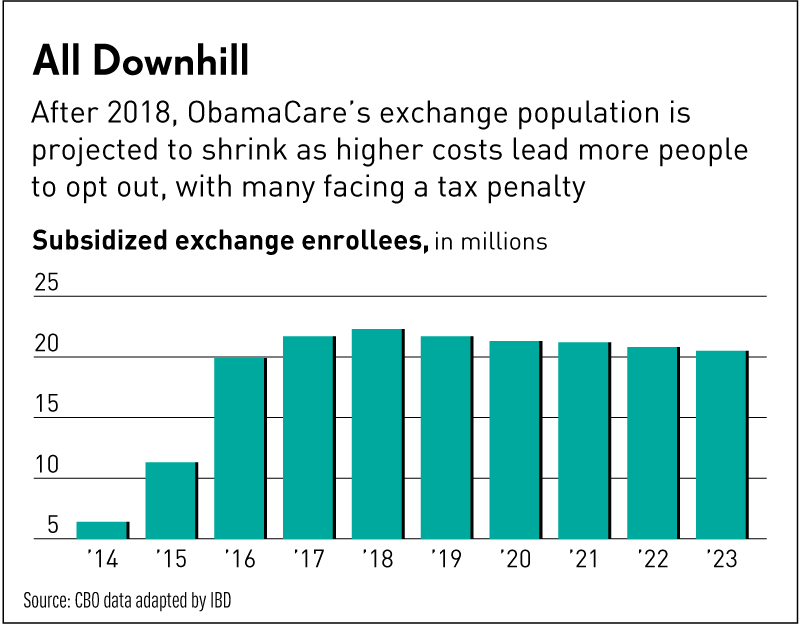Obamacare Exchanges To Shed Users After 2018

It's funny what dry numbers can reveal. As reported over at Investors Business Daily, the latest Congressional Budget Office projections for the Affordable Care Act show the health care exchanges that the federal government and about half of the states struggle to establish attracting a growing base of users until 2018 — after which the numbers start to decline. At the same time, penalties paid by individuals and businesses for failing to meet the health insurance requirements of the new law are expected to rise. The take-away is that, very soon, many Americans are expected to opt to pay the penalty rather than buy health insurance.
From Jed Graham of Investors Business Daily:
After 2018, ObamaCare exchanges will be all downhill.
At least that's how it looks to the Congressional Budget Office. Its projections imply that the number of people getting subsidized coverage will ramp up from the 2014 start to peak at 22.3 million in 2018, but then fall by 1.8 million over the next five years.
The ObamaCare exchange exodus would result from subsidies covering a smaller share of premiums over time, leading more people to go without insurance and, in many cases, pay a tax penalty.
Sure enough, CBO figures (PDF) show health exchange usage by subsidized individual purchasers rising from roughly six million Americans in 2014 to roughly 22 million in 2017. After that, it starts falling off — not by a huge amount, but exchange use by subsidized individual purchasers is expected to decline after 2018.
The same CBO document projects penalty payments by uninsured individuals to rise from $3 billion in 2015 to $6 billion in 2017 to $7 billion in 2021. (Penalty payments by employers are seen rising even more dramatically, from $5 billion in 2014 to $21 billion in 2023).
Why?
Writes Graham:
The exchanges' declining future is largely tied to a little-understood last-minute cost-control inserted to make ObamaCare seem more fiscally responsible. It kicks in after 2018 if exchange subsidies top 0.5% of GDP — as CBO estimates show they surely will.
Health policy experts first interpreted the provision to mean that premium subsidies would only grow with overall inflation, well below health cost inflation. The reality, clarified by CBO in 2011, is much different.
For lower-income and older households for whom ObamaCare would cover the bulk of premiums, subsidies would continue to grow faster than inflation.
For younger and higher-income households, ObamaCare subsidies could begin to shrink outright, as IBD has reported.
That seems like something of a paltry payoff for the much-touted and fought-over exchanges which, as Peter Suderman has noted, have proven to be "a big task, with major information technology procurement issues that have already caused headaches for early implementation efforts."
See the full Investors Business Daily story here.
